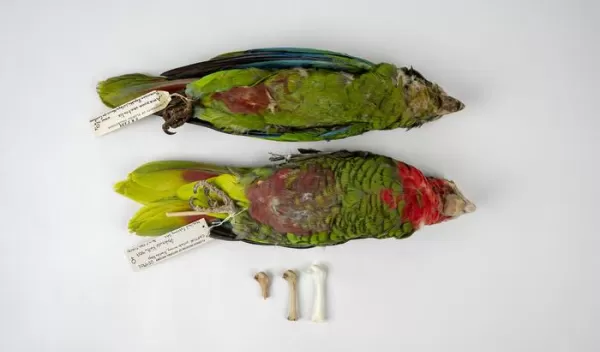
Caribbean parrots thought to be endemic are relicts of millennial-scale extinction
In a study supported in part by the U.S. National Science Foundation and published in the journal PNAS, researchers have extracted the first ancient DNA from Caribbean parrots, which they compared with genetic sequences from modern birds.
Working with fossils and archaeological specimens, scientists at the Florida Museum of Natural History and other institutions showed that two species thought to be endemic to islands were once more widespread and diverse. The results help explain how parrots rapidly became the world's most endangered group of birds, with 28% of all species considered to be threatened. This is especially true for parrots that inhabit islands.
"This study shows that integrative research combining history, genetics and museum-based research, including ancient DNA analyses from fossils, can reveal the complicated consequences of human-induced biodiversity loss," says Matthew Fujita, a program director in NSF's Division of Environmental Biology.
On his first voyage to the Caribbean in 1492, Christopher Columbus noted that flocks of parrots were so abundant they "obscured the sun." Today, more than half of parrot species in the Caribbean have gone extinct, from large parti-colored macaws to a parrotlet the size of a sparrow.
Biologists attempting to conserve the remaining parrot species are stymied by how little is known of their former distributions. That is due, primarily, to their complicated history with humans.
The authors pieced together the long history of parrots in the genus Amazona, focusing on two species — the Cuban (A. leucocephala) and Hispaniolan (A. ventralis) parrots — for which they could obtain ancient DNA samples.
Of the two, Cuban parrots are currently the most widespread, with isolated populations in Cuba and on a few islands in the Bahamas and Turks and Caicos. They're one of the only native parrots in the region not in imminent danger of extinction.
Most of the fragmentary fossils collected outside of Hispaniola and Puerto Rico were consequently identified as belonging to the more common Cuban parrots. But when the DNA results came back, they told a different story. The fossils from the Bahamian paleontological sites were actually from Hispaniolan parrots, indicating that this species formerly had a range that extended up through the Bahamas before human arrival to the islands.
Similarly, the results indicate that Cuban parrots once inhabited the largest island in the Turks and Caicos, from which they are now absent.
Knowing where species once thrived — both naturally by their own devices and artificially with the aid of humans — is the first step to conserving what's left of their diversity, the scientists say.
